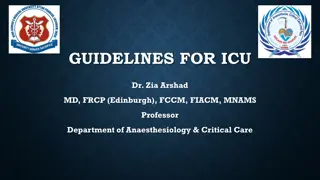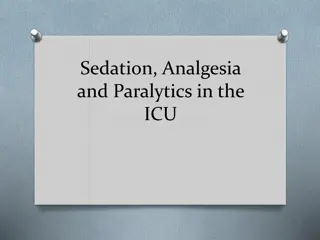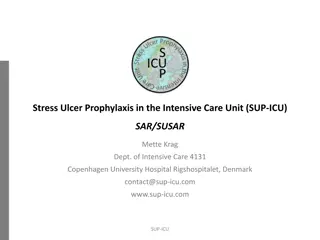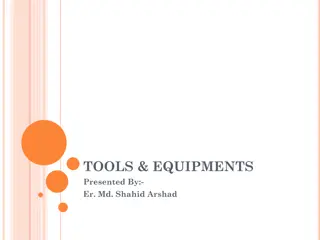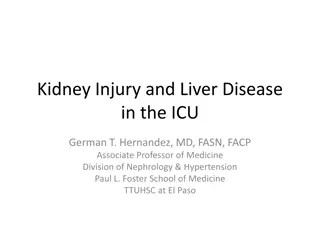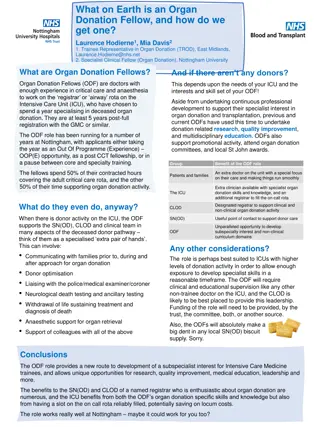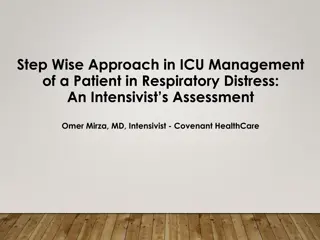Understanding Common Equipment and Systems in ICU
Common equipment in an ICU includes mechanical ventilators, cardiac monitors, monitoring equipment for bodily functions, and a variety of tubes, lines, and pumps. Drugs like analgesics are used to reduce pain and prevent infections. Monitors track heart rate, blood pressure, and temperature, while tools like respiratory rate monitor and blood pressure cuff help in patient care.
Download Presentation

Please find below an Image/Link to download the presentation.
The content on the website is provided AS IS for your information and personal use only. It may not be sold, licensed, or shared on other websites without obtaining consent from the author. Download presentation by click this link. If you encounter any issues during the download, it is possible that the publisher has removed the file from their server.
E N D
Presentation Transcript
L 2 Dr_ Dr_Zainab Zainab Al M. M.B. B.Ch. Ch.B B / /FICMS. Al Youseif Youseif FICMS.A& A&IC IC
Equipment and systems Common equipment in an ICU includes mechanical ventilators to assist breathing through an endotracheal tube or a tracheostomy tube; cardiac monitors for monitoring Cardiac condition; equipment for the constant monitoring of bodily functions; a web of intravenous lines, feeding tubes, nasogastric tubes, suction, drains, and catheters, syringe pumps; and a wide array of drugs to treat the primary condition(s) of hospitalization. analgesics, and induced sedation are common ICU tools needed and used to reduce pain and prevent secondary infections.
The most basic monitors showyour heart rate, blood pressure, and body temperature. More advanced modelsshow respiratory rate and how much carbon dioxide you're breathing out.
HR The hearts of healthy adults typically beat 60 to 100 times a minute. People who are more active can have slower heart rates What are the causes of an increased heart rate?
Respiratory Rate (RR) Respiratory Rate (RR): Look for the patient's respiratory rate under RR on the patient monitor. It is reported in breaths per minute, with normal values between 12 and 20. However, this number isn't very accurate, especially as the patient's breathing goes faster or slower. What are the causes of an increased RR?
Blood pressure This is a measure of the force on your arteries when your heart is beating (known as systolic pressure) and when it s at rest (diastolic pressure). The first number (systolic) should be between 100 and 130, and the second number (diastolic) should be between 60 and 80.
Oxygen saturation This number measures how much oxygen is in your blood, on a scale up to 100. The number is normally 95 or higher, and anything below 90 means your body may not be getting enough oxygen.
If one of your vital signs rises or falls outside healthy levels, the monitor will sound a warning. This usually involves a beeping noise and a flashing color. Many will highlight the problem reading in some way If one or more vital signs spikes or drops sharply, the alarm may get louder, faster, or change in pitch. This is designed to let a caregiver know to check on you, so the alarm may also show up on a monitor in another room. But one of the most common reasons an alarm goes off is because a sensor isn t getting any information. This might happen if one comes loose when you move or isn t working the way it should.
ETCO2 The capnogram is a direct monitor of the inhaled and exhaled concentration or partial pressure of CO2, and an indirect monitor of the CO2 partial pressure in the arterial blood. In healthy individuals, the difference between arterial blood and expired gas CO2, partial pressures is very small. the difference between arterial blood and expired gas can exceed 7 mmHg in some disease
Capnography directly reflects the elimination of CO2 by the lungs to the anesthesia device. Indirectly, it reflects the production of CO2 by tissues and the circulatory trans Carbon dioxide is produced continuously as the body's cells respire, and this CO2will accumulate rapidly if the lungs do not adequately expel it through alveolarventilation. Alveolar hypoventilation thus leads to an increased PaCO2(a condition called hypercapnia). The increase in PaCO2in turn decrease the pH.
DC shock used for patients with VT, VF, SVT .
suction machine Suction machines create a vacuum effect to remove obstructions such as blood, saliva, mucus, vomit, or other liquids from the respiratory tract. Suctionof the endotracheal tube (ETT) is routine and common procedure in intensive care unit to clear secretions and to keep the airway patent so that oxygenation and ventilation in an intubated patient can be optimized. ETT suction can cause hypoxia due to oxygen suction from the lung and alveoli collapse.
The following are recommendations for endotracheal suctioning from the American Association of Respiratory Care: Saw tooth pattern on flow-volume loop on ventilator monitor Coarse crackles auscultated over trachea Increased peak inspiratory pressure during volume control ventilation Decreased tidal volume during pressure-controlled ventilation Deterioration in oxygen saturation and/or arterial blood gas values Visible secretions in airway Patient s inability to generate an effective cough Acute respiratory distress Suspected aspiration of gastric or upper airway secretions
procedure hyperoxygenate the patient by giving them a few breaths with 100% oxygen Insert the catheter through the nose, tracheostomy tube or endotracheal tube. Do not be aggressive when inserting the tube through the nose. Once the catheter has been inserted to the appropriate depth, apply intermittent suction and slowly withdraw the catheter If suctioning more than once, allow the patient time to recover between suctioning attempts During the procedure, monitor oxygen levels and heart rate to make sure the patient is tolerating the procedure well. Suctioning attempts should be limited to 10 seconds
Tips Apply suction for no longer than 10 seconds. Applying suction for longer periods of ti me can cause injury, hypoxia and bradycardia. Do not apply suction while inserting the catheter. This can increase the chances of in juring the mucus membranes. Use a clean suction catheter when suctioning the patient. Whenever the suction c atheter is to be reused, place the catheter in a container of distilled/sterile water and apply suction for approximately 30 seconds to clear secretions from the inside. Reoxygenate between attempts. Maximum number of attempts should be 2 suctio n passes/episode. Suction catheter size should be no more than 1/2 (one-half) the i nternal diameter of the artificial airway (ETT) to avoid greater negative pressure in t he airway and potentially minimize the PaO2.
syringe pump used to given bolus dose ( not for infusion) like 10 mg midazolam in every 6 hours
syringe pump A syringe pump is a small infusiondevice that is used togradually administer specific amounts of fluids for use in chemical and biomedical research. A syringe pump is also known as Micro Infusion Pump The main purpose of the equipment is to supplement volumetric infusion pump in micro-administration It is more accurate than a typical volumetric infusion pump while administering small doses
Pump infusion used for infusion doses drugs like dopamine 10 mcg/kg/min (not for bolus dose)
Pump infusion Majority of the patients in ICU need these pumps. These are pumps that you will see beside the patient and they control the amount of medication or fluid that a patient receives and how fast or slow it can be given. used for Chemotherapy parenteral nutrition Anaesthesia/sedation Drugs like (dopamine, epinephrine, dobutamine, )
Majority of the patients in ICU need these pumps. These are pumps that you will see beside the patient and they control the amount of medication or fluid that a patient receives and how fast or slow it can be given.
Advantages Infusion pumps provide a high level of control, accuracy, and precision in drug delivery, thereby reducing medication errors and contributing to improvements in patient care. At the same time, infusion pumps have been associated with persistent safety problems that can result in over- or under-infusion, and missed ordelayed therapy. Infusion pump used an unit ml/houror mcg/hour You can determine thedrug and dose You can determine theduration of administration An alarm for any obstruction to access and when the amount of medicine in the vial orcontainer is running out
CV line (center venous line) A central venous catheter (CVC), also known as a central line, central venous line, or central venous access catheter, is a catheter placed into a large vein. It is a form of venous access. Placement of larger catheters in more centrally located veins is often needed in critically ill patients, or in those requiring prolonged intravenous therapies, for more reliable vascular access. These catheters are commonly placed in veins in the neck (internal jugular vein), chest (subclavianvein or axillary vein), groin (femoral vein), or through veins in the arms.
ECG The electrocardiogram (ECG ) is a diagnostic tool that is routinely used to assess the electrical and muscular functions of the heart. it gives the full information about the heart beats consists of 12 leads for acquistionand a rhythm lead as an optional. it is used to analyse the heart rate and rhythm of the heart.
Endotracheal tube (ETT) It is used in the ICU for patients who are having difficulty breathing because of a lung problem, or for patients who are not awake enough to breathe for themselves.
Tracheostomy A tracheostomy is sometimes and option to patients who require long term ventilation, difficult weaning from the ventilator, and patients with copious secretions . When a patient no longer requires ventilator support and only needs oxygen therapy, oxygen tube can be connected to the tracheostomy.
Arterial line It allows the nurse to see the blood pressure continuously and also allows the staff to take bloods when required
Direct current (DC) cardioversion or defibrillation Defibrillation is a common treatment for life-threatening cardiac dysrhythmias, ventricular fibrillation and pulseless ventricular tachycardia. Defibrillation consists of delivering a therapeutic dose of electrical energy to the heart with a device called a defibrillator The purpose of defibrillator is to give electrical stimulation for cardiac arrest patients
Pressure Relieving Mattress ('Air mattress') The majority of our patients will be lying on an air mattress. This mattress is used to prevent pressure injuries or 'bed sores' The air mattress is constantly distributing air and alternating the pressure under the body. In addition to the use of an air mattress we should also turn the patients in the bed frequently
Nasogastric Tube (NG) This tube goes through a patients nose and down into their stomach. It allows us to feed them when they are too unwell to eat and drink as they normally would or when their appetite is reduced due to illness. We can also give them medication
Urinary Catheter In the ICU, a patient may have a urinary catheter put in place to monitor an hourly output. This allows us to calculate how much fluid is going in, versus how much is coming out
Kidney machines Some patients kidneys stop working due to their illness. The kidneys work to filter the blood and remove waste products (and in doing so produce urine) so if they fail, it is important that the machines take over this job. To do this a special large tube is put into one of the big veins in the leg or neck.



